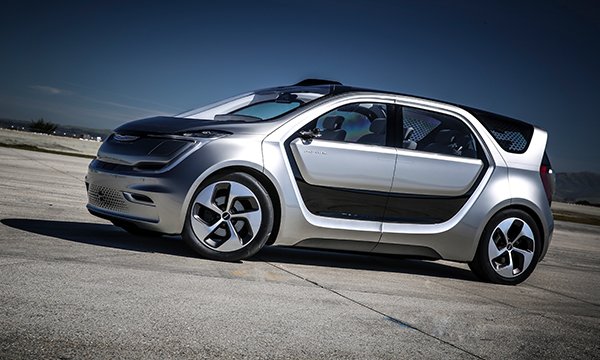Corn Ethanol Under Pressure

Now, it’s easy to say that this whole concept needs to go away, since, after all these decades we’ve seen that there are dozens of unintended, albeit horrific, environmental consequences. Yet, because of politics, corn ethanol will be around for a very long time; a platform to remove subsidies for corn would be like saying you challenge the idea of mass incarceration, that you want to ban assault rifles, or favor universal healthcare. I.e., suicide.
Fortunately, the penetration of electric vehicles and the possibility of stranded ethanol assets is already putting corn farmers under pressure.
Chrysler’s new “Portal” electric SUV looks great to me, but it’s certainly not targeted towards my generation. From Fiat Chrysler’s website:
To create the next generation family transportation, FCA sought the collaboration and fresh ideas of millennials working inside its design and engineering functions. Those ideas led to the Chrysler Portal concept — created by millennials for millennials.
Millennials are a tech-savvy, environmentally-aware, cost-conscious generation. The Chrysler Portal concept is designed to respond to these needs and it explores the possibility of what a family transportation vehicle could look like for the millennial generation as their lifestyles evolve.
The flexibility, adaptability and technology features also make it ideal for business and commercial applications, such as ride hailing, car sharing and delivery services.

Craig,
Well said, very well said indeed ! The US experiment with Corn based ethanol was a noble experiment and one which made good sense back when initiated by President Carter.
Since then it’s grown to an absolute American and global environmental catastrophe. I feel the pain of the farmer and the ethanol industry for whom this technology is the mainstay of their economic existence, but it simply can’t continue a solution must be found to end the production of this product.
As for Chrysler’s little vehicle, it reminds me a bit of the Simpson’s episode where Homer is placed in charge of designing an automobile!
Creating a new auto-model is extremely difficult and always a gamble. Consumers are very fickle and very seldom behave in a rational manner. Opinion polls and focus groups usually reflect the opinions people feel they “should” contribute, but in reality these opinions seldom reflect what they will actually purchase.
Vehicles purchasing trends are notoriously difficult to predict. In Australia, a nation with one of the worlds highest car ownership per capita, (but no EV government incentives), the Nissan Leaf has been outsold by Tesla 10 to one !
However, both EV’s are dwarfed by the enormous demand for the V8 powered Ford Mustang! Despite very high insurance rates and a huge luxury tax price disincentive, Australia’s love affair with the product of Ford’s Flat Rock Assembly Plant continues unabated.
The Mustang is almost primitive in comparison to it’s more hi-tech rivals, yet over 500,000 have found a home with enthusiastic American owners, completely dwarfing the total number of EV’s sold in the USA.
(Remove Tesla sales and EV sales collapse to the point where EV enthusiast’s are forced to desperately include any PHEV to even equal on months sales of the Mustang.).
I wish Chrysler the best of luck, I had great fun back in 1963 with my ’62 Super Stock Dodge Max Wedge 41. Mine was a very early ‘code 8 ” model, although fitted with “export” luxury trim, radio etc 4 carburetors, police grade suspension, racing transmission and converted to right hand drive.
The car was a sensation in Australia, making my school holidays in Australia especially exciting and worth the 29 hour long flight from London to Sydney. On arrival Sydney, I would collect my 413 from storage in a garage owned by family friends. After a spending a short time in Sydney, I had the fun of driving nearly 800 miles to my mother’s home.
New American cars were still a rarity in Australia at that time, although a standard six cylinder version was locally assembled as and sold as a Chrysler S type Valiant. This was considered a prestige luxury model in Australia at that time.
It seemed every Australian town and city possessed an endless number of Australian hot-rod enthusiasts willing to blow engines and transmissions attempting to outperform my Mopar muscle car ! ( No chance!)
When the Beach Boys hit song came out, I was indignant at the idea of a ‘plastic’ (fibre-glass) GM Corvette beating my fire breathing dragon ! (still loved the song).
To me, that car symbolized the youth, health, sunshine, freedom, optimism and prosperity of Australia and America in contrast with the grim, dismal, weary, pessimistic shabbiness of “socialist Britain”, with its endless petty quarrels and class warfare about how to divide an ever decreasing national cake.
I guess my point is, car ownership was a very emotive decision. It will be interesting to see if ride hailing, car sharing and delivery services can completely replace that experience, despite the prevalence of lives lived predominantly on the internet.
Very well said. Car ownership is more than just spending some money to ease transport, it’s an experience we will never forget. Everyone remembers the first time they got in a car and drove. It is both stressful and exhilarating.